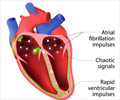
‘By monitoring the Heart co-ordination activity personalized decisions can be made to help refine patient selection and reduce the failure rate of an expensive catheter ablation procedure. This can also help candidates with low potential benefit from futile procedures and complications.’
Tweet it Now
Atrial fibrillation, diagnosed in 3.4 million Americans and the most common heart rhythm condition in the United States, is marked by irregular and sometimes extremely rapid heart rates that cause fatigue and shortness of breath, and significantly increase the risk of heart failure and stroke. Treatments include drugs to regulate the electrical pulses in the upper chambers of the heart and ¾ increasingly ¾ catheter ablation. Catheter ablation procedure involves general anesthesia and imaging guided use of a wire catheter threaded through a vein to the heart to make scores of tiny burns of tissue in which the irregular heartbeats arise.
However, an estimated 20 to 30 percent of the ablation procedures performed each year fail to prevent irregular heart rhythms, and cardiologists have long sought various biological or anatomical factors to help them determine in advance which patients are the best candidates for ablation.
"In our study, we found that the best indicator of success is how in sync the left atrium chamber of the heart is when it relaxes," says Luisa Ciuffo, M.D., a postdoctoral fellow in the Division of Cardiology at the Johns Hopkins University School of Medicine. "Diseased, damaged hearts with a lot of scar tissue don't contract and relax at the same time throughout the atrium because it is more difficult to rhythmically contract the thicker, tougher damaged tissue."
For the study, designed to identify the best predictors, the researchers used data from 208 atrial fibrillation or "Afib" patients admitted to The Johns Hopkins Hospital to undergo ablation between June 2010 and December 2015.
Advertisement
The researchers then analyzed various characteristics of the imaging scans from 208 people in a subgroup: 107 of the people with successful ablations compared to 101 of those with failed ablations. The researchers investigated factors such as smallest and largest sizes of the left atria, the percentage of blood pushed out of the left atrium when the heart contracted and the amount of strain on the left atrium during heart contraction.
Advertisement
Overall, the Johns Hopkins researchers found that patients with recurrent atrial fibrillation had on average more preoperative dys-synchrony throughout the left atrium than those who had successful ablations (3.9 percent versus 2.2 percent), with the higher value indicating more diseased atrium.
In a second part of the research, the investigators took the scans from a group of 103 patients, both with successful and unsuccessful ablations, analyzed the percentage of atrial dys-synchrony in the left atrium and assigned them to one of two groups: one less than or another greater than 2.86 percent.
They expected those people with values lower than 2.86 percent to be better candidates for ablation because atrial fibrillation would be less likely to recur than in those people with more than the 2.86 percent cutoff. They then compared these groupings to their actual outcomes after ablation. They found that their model had a 76 percent sensitivity ¾ the ability to correctly identify those who were unlikely to have successful ablations ¾ and 81 percent specificity ¾ the ability to correctly identify those who would most likely have successful ablations.
"We believe we are developing a tool that can help with personalized decision-making to help refine patient selection and thus reduce the failure rate by saving candidates with low potential benefit from futile procedures and complications," says senior author Hiroshi Ashikaga, M.D., Ph.D., assistant professor of medicine at the Johns Hopkins University School of Medicine.
An ablation procedure isn't cheap, says Ciuffo, sometimes costing as much as a new car. The cost of cardiac imaging typically performed before the ablation procedure is a fraction of the cost of the procedure.
Although the risk of complication is small, about 6 percent with ablation, there is still the chance of puncturing the heart or forming a fistula.
Source-Eurekalert













